Android ShapeableImageView 使用详解,告别 shape、三方库 (2)
android:layout_margin="10dp"
android:padding="2dp"
android:src="@mipmap/ic_avatar"
app:shapeAppearance="@style/RhombusStyle"
app:strokeColor="@color/red"
app:strokeWidth="4dp" />
<style name="RhombusStyle">
<item name="cornerFamily">cut</item>
<item name="cornerSize">50%</item>
</style>
同样,裁剪模式下圆角大小也可以计算
[](
)叶子

<com.google.android.material.imageview.ShapeableImageView
android:layout_width="wrap_content"
android:layout_height="wrap_content"
android:layout_margin="10dp"
android:padding="2dp"
android:src="@mipmap/ic_avatar"
app:shapeAppearance="@style/LeafStyle"
app:strokeColor="@color/red"
app:strokeWidth="4dp" />
<style name="LeafStyle">
<item name="cornerFamily">rounded</item>
<item name="cornerSizeTopLeft">50%</item>
<item name="cornerSizeBottomRight">50%</item>
</style>
cornerSizeTopLeft 左上圆角
cornerSizeBottomRight 右下圆角
以此类推,左上、左下、右上、右下等
[](
)半圆

<com.google.android.material.imageview.ShapeableImageView
android:layout_width="wrap_content"
android:layout_height="wrap_content"
android:layout_margin="10dp"
android:padding="2dp"
android:src="@mipmap/ic_avatar"
app:shapeAppearance="@style/SemicircleStyle"
app:strokeColor="@color/red"
app:strokeWidth="4dp" />
<style name="SemicircleStyle">
<item name="cornerFamily">rounded</item>
<item name="cornerSizeTopLeft">50%</item>
<item name="cornerSizeTopRight">50%</item>
</style>
[](
)六边形

<com.google.android.material.imageview.ShapeableImageView
android:layout_width="wrap_content"
android:layout_height="50dp"
android:layout_margin="10dp"
android:padding="2dp"
android:scaleType="centerCrop"
android:src="@mipmap/ic_avatar"
app:shapeAppearance="@style/HexagonStyle"
app:strokeColor="@color/red"
app:strokeWidth="4dp" />
<style name="HexagonStyle">
<item name="cornerFamily">cut</item>
<item name="cornerSizeTopLeft">50%</item>
<item name="cornerSizeTopRight">50%</item>
<item name="cornerSizeBottomLeft">50%</item>
<item name="cornerSizeBottomRight">50%</item>
</style>
author:[yechaoa](
)
[](
)属性
=============================================================
关于 xml 属性,我也做了一个整理,属性不多,只有 4 个
| 属性 | 描述 |
| --- | --- |
| strokeWidth | 描边宽度 |
| strokeColor | 描边颜色 |
| shapeAppearance | 外观样式 |
| shapeAppearanceOverlay | 同上,叠加层 |
[](
)扩展
=============================================================
前面为了整体的排版,埋了几个伏笔,下面来一一解答。
会涉及到源码,但是经过去繁从简,看起来也非常轻松的。
[](
)shapeAppearance
Shape appearance overlay style reference for ShapeableImageView.
ShapeableImageView 的形状外观覆盖样式参考。
前面可以看到我们设置圆角其实是用的style,那为什么不直接用attrs呢,不是更加直观方便吗,带着疑问来看看源码是怎么处理的。
直接看ShapeableImageView的次构造方法:
public class ShapeableImageView extends AppCompatImageView implements Shapeable {
...
public ShapeableImageView(Context context, @Nullable AttributeSet attrs, int defStyle) {
super(wrap(context, attrs, defStyle, DEF_STYLE_RES), attrs, defStyle);
// Ensure we are using the correctly themed context rather than the context that was passed in.
context = getContext();
clearPaint = new Paint();
clearPaint.setAntiAlias(true);
clearPaint.setColor(Color.WHITE);
clearPaint.setXfermode(new PorterDuffXfermode(Mode.DST_OUT));
destination = new RectF();
maskRect = new RectF();
maskPath = new Path();
TypedArray attributes =
context.obtainStyledAttributes(
attrs, R.styleable.ShapeableImageView, defStyle, DEF_STYLE_RES);
strokeColor =
MaterialResources.getColorStateList(
context, attributes, R.styleable.ShapeableImageView_strokeColor);
strokeWidth = attributes.getDimensionPixelSize(R.styleable.ShapeableImageView_strokeWidth, 0);
borderPaint = new Paint();
borderPaint.setStyle(Style.STROKE);
borderPaint.setAntiAlias(true);
shapeAppearanceModel =
ShapeAppearanceModel.builder(context, attrs, defStyle, DEF_STYLE_RES).build();
shadowDrawable = new MaterialShapeDrawable(shapeAppearanceModel);
if (VERSION.SDK_INT >= VERSION_CODES.LOLLIPOP) {
setOutlineProvider(new OutlineProvider());
}
}
}
常规操作,获取自定义属性。
关键的两行代码:
shapeAppearanceModel = ShapeAppearanceModel.builder(context, attrs, defStyle, DEF_STYLE_RES).build();
shadowDrawable = new MaterialShapeDrawable(shapeAppearanceModel);
也就是说我们给shapeAppearance设置的 style,并不是ShapeableImageView自己来处理的,而是由ShapeAppearanceModel来构建的,然后又交给MaterialShapeDrawable来绘制的。
[](
)ShapeAppearanceModel
这个类就厉害了,有点像Flutter中的 Decoration,可以构建出花里胡哨的效果。
来看ShapeAppearanceModel部分源码:
public class ShapeAppearanceModel {
/** Builder to create instances of {@link ShapeAppearanceModel}s. */
public static final class Builder {
@NonNull
private CornerTreatment topLeftCorner = MaterialShapeUtils.createDefaultCornerTreatment();
@NonNull
private CornerTreatment topRightCorner = MaterialShapeUtils.createDefaultCornerTreatment();
@NonNull
private CornerTreatment bottomRightCorner = MaterialShapeUtils.createDefaultCornerTreatment();
@NonNull
private CornerTreatment bottomLeftCorner = MaterialShapeUtils.createDefaultCornerTreatment();
@NonNull private CornerSize topLeftCornerSize = new AbsoluteCornerSize(0);
@NonNull private CornerSize topRightCornerSize = new AbsoluteCornerSize(0);
@NonNull private CornerSize bottomRightCornerSize = new AbsoluteCornerSize(0);
@NonNull private CornerSize bottomLeftCornerSize = new AbsoluteCornerSize(0);
@NonNull private EdgeTreatment topEdge = MaterialS
hapeUtils.createDefaultEdgeTreatment();
@NonNull private EdgeTreatment rightEdge = MaterialShapeUtils.createDefaultEdgeTreatment();
@NonNull private EdgeTreatment bottomEdge = MaterialShapeUtils.createDefaultEdgeTreatment();
@NonNull private EdgeTreatment leftEdge = MaterialShapeUtils.createDefaultEdgeTreatment();
public Builder() {}
...
}
...
}
可以看到有各种边和角的属性,这里注意两个点:
MaterialShapeUtils.createDefaultCornerTreatment()创建默认角的处理方式MaterialShapeUtils.createDefaultEdgeTreatment()创建默认边的处理方式
也就意味着,边和角除了默认,是可以自定义的,这就有极大的想象空间了,
比如这样:

// 代码设置 角和边
val shapeAppearanceModel2 = ShapeAppearanceModel.builder().apply {
setAllCorners(RoundedCornerTreatment())
setAllCornerSizes(50f)
setAllEdges(TriangleEdgeTreatment(50f, false))
}.build()
val drawable2 = MaterialShapeDrawable(shapeAppearanceModel2).apply {
setTint(ContextCompat.getColor(this@ShapeableImageViewActivity, R.color.colorPrimary))
paintStyle = Paint.Style.FILL_AND_STROKE
strokeWidth = 50f
strokeColor = ContextCompat.getColorStateList(this@ShapeableImageViewActivity, R.color.red)
}
mBinding.text2.setTextColor(Color.WHITE)
mBinding.text2.background = drawable2
再比如这样:

// 代码设置 聊天框效果
val shapeAppearanceModel3 = ShapeAppearanceModel.builder().apply {
setAllCorners(RoundedCornerTreatment())
setAllCornerSizes(20f)
setRightEdge(object : TriangleEdgeTreatment(20f, false) {
// center 位置 , interpolation 角的大小
override fun getEdgePath(length: Float, center: Float, interpolation: Float, shapePath: ShapePath) {
super.getEdgePath(length, 35f, interpolation, shapePath)
}
})
}.build()
val drawable3 = MaterialShapeDrawable(shapeAppearanceModel3).apply {
setTint(ContextCompat.getColor(this@ShapeableImageViewActivity, R.color.colorPrimary))
paintStyle = Paint.Style.FILL
}
(mBinding.text3.parent as ViewGroup).clipChildren = false // 不限制子 view 在其范围内
mBinding.text3.setTextColor(Color.WHITE)
mBinding.text3.background = drawable3
[](
)MaterialShapeDrawable
源码(有删减):
public class MaterialShapeDrawable extends Drawable implements TintAwareDrawable, Shapeable {
...
@Override
public void draw(@NonNull Canvas canvas) {
fillPaint.setColorFilter(tintFilter);
final int prevAlpha = fillPaint.getAlpha();
fillPaint.setAlpha(modulateAlpha(prevAlpha, drawableState.alpha));
strokePaint.setColorFilter(strokeTintFilter);
strokePaint.setStrokeWidth(drawableState.strokeWidth);
final int prevStrokeAlpha = strokePaint.getAlpha();
strokePaint.setAlpha(modulateAlpha(prevStrokeAlpha, drawableState.alpha));
if (pathDirty) {
calculateStrokePath();
calculatePath(getBoundsAsRectF(), path);
pathDirty = false;
}
maybeDrawCompatShadow(canvas);
if (hasFill()) {
drawFillShape(canvas);
}
if (hasStroke()) {
drawStrokeShape(canvas);
}
...
static final class MaterialShapeDrawableState extends ConstantState {
...
public MaterialShapeDrawableState(@NonNull MaterialShapeDrawableState orig) {
shapeAppearanceModel = orig.shapeAppearanceModel;
elevationOverlayProvider = orig.elevationOverlayProvider;
strokeWidth = orig.strokeWidth;
colorFilter = orig.colorFilter;
fillColor = orig.fillColor;
strokeColor = orig.strokeColor;
tintMode = orig.tintMode;
tintList = orig.tintList;
alpha = orig.alpha;
scale = orig.scale;
shadowCompatOffset = orig.shadowCompatOffset;
shadowCompatMode = orig.shadowCompatMode;
useTintColorForShadow = orig.useTintColorForShadow;
interpolation = orig.interpolation;
parentAbsoluteElevation = orig.parentAbsoluteElevation;
elevation = orig.elevation;
translationZ = orig.translationZ;
shadowCompatRadius = orig.shadowCompatRadius;
shadowCompatRotation = orig.shadowCompatRotation;
strokeTintList = orig.strokeTintList;
paintStyle = orig.paintStyle;
if (orig.padding != null) {
padding = new Rect(orig.padding);
}
}
...
}
...
}
没什么特别的,你只需要知道除了可以设置描边之外,还可以设置背景、阴影等其他属性。
[](
)说明












评论